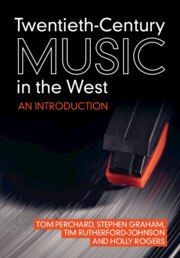Book contents
- Twentieth-Century Music in the West
- Twentieth-Century Music in the West
- Copyright page
- Contents
- Figures
- Tables
- Acknowledgements
- Introduction
- Part I Histories
- Part II Techniques and Technologies
- Part III Mediation
- Part IV Identities
- 13 Gender and Sexuality
- 14 Race and Ethnicity
- 15 Audiences, Class and Consumption
- 16 Centres and Peripheries
- Bibliography
- Index
15 - Audiences, Class and Consumption
from Part IV - Identities
Published online by Cambridge University Press: 15 September 2022
- Twentieth-Century Music in the West
- Twentieth-Century Music in the West
- Copyright page
- Contents
- Figures
- Tables
- Acknowledgements
- Introduction
- Part I Histories
- Part II Techniques and Technologies
- Part III Mediation
- Part IV Identities
- 13 Gender and Sexuality
- 14 Race and Ethnicity
- 15 Audiences, Class and Consumption
- 16 Centres and Peripheries
- Bibliography
- Index
Summary
One of the most significant developments of the cultural twentieth century was the related emergence of ‘mass’ cultural practices and an urban, diverse, ‘mass’ audience to go along with them. The industrialising late eighteenth and nineteenth centuries had set the scene, with explosions in wealth, technology and population generating new leisure activities, from pleasure gardens to music halls, galleries to museums, street theatre to vaudeville, all of which were populated by an increasingly mixed crowd (Storch 1982; Cunningham 1980; Oldcorn Reid 1976). Consumption habits were changing, as were audiences. But it was the twentieth-century introduction of mass media and propulsive economic policies such as the New Deal that would most fully realise this drift towards large, mixed audiences and new forms of culture, something that would impact both mass and more specialised culture in profound ways.
- Type
- Chapter
- Information
- Twentieth-Century Music in the WestAn Introduction, pp. 362 - 380Publisher: Cambridge University PressPrint publication year: 2022

